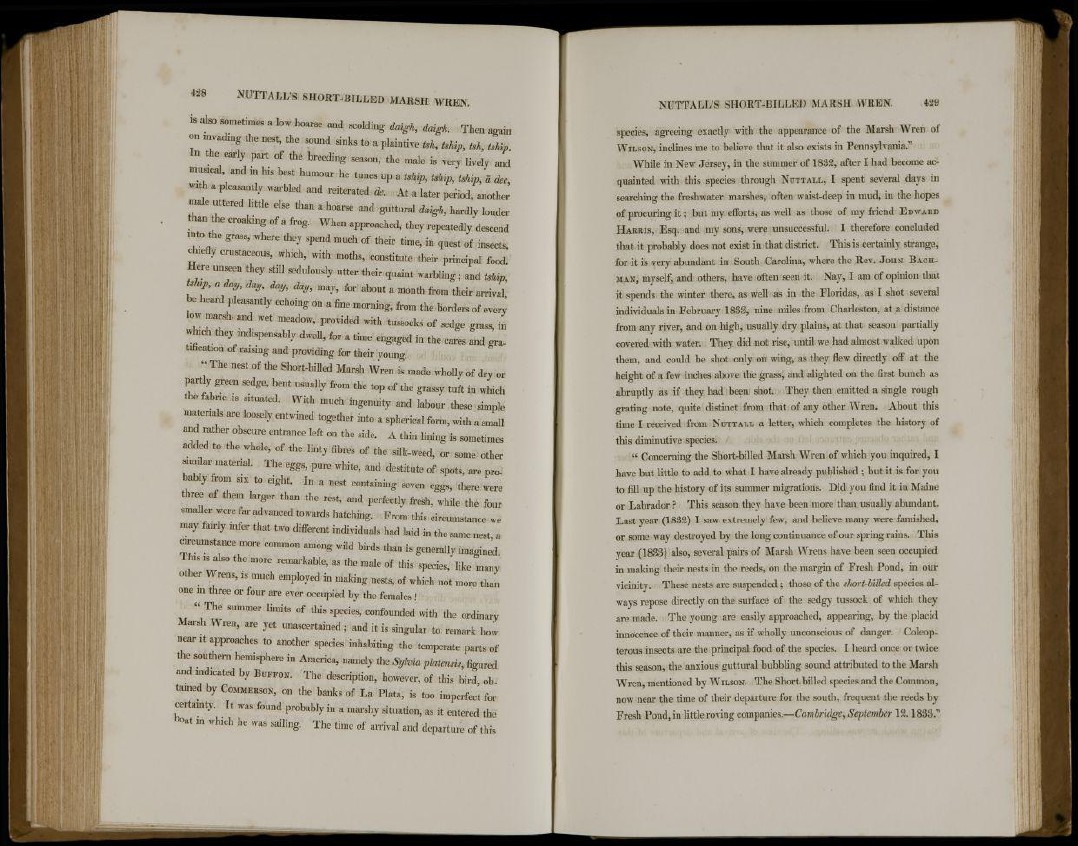
428
N U T T A L L ' S S H O R T - B I L L E D M A R S H WREN.
is also sometimes a low hoarse and scolding daigh, daigh. Then again
on invading the nest, the sound sinks to a plaintive tsh, tship, tsh, tship.
In the early part of the breeding season, the male is very lively and
musical, and in his best humour he tunes up a tship, tship, tship, a dee,
with a pleasantly warbled and reiterated de. At a later period, another
male uttered little else than a hoarse and guttural daigh, hardly louder
than the croaking of a frog. When approached, they repeatedly descend
into the grass, where they spend much of their time, in quest of insects,
chiefly crustaceous, which, with moths, constitute their principal food.
Here unseen they still sedulously utter their quaint warbling; and tship,
tship, a day, day, day, day, may, for about a month from their arrival,
be heard pleasantly echoing on a fine morning, from the borders of every
low marsh- and Avet meadow, provided with tussocks of sedge grass, in
which they indispensably dwell, for a time engaged in the cares and gratification
of raising and providing for their young.
" The nest of the Short-billed Marsh Wren is made wholly of dry or
partly green sedge, bent usually from the top of the grassy tuft in which
the fabric is situated. With much ingenuity and labour these simple
materials are loosely entwined together into a spherical form, with a small
and rather obscure entrance left on the side. A thin lining is sometimes
added to the whole, of the linty fibres of the silk-weed, or some other
similar material. The eggs, pure white, and destitute of spots, are probably
from six to eight. In a nest containing seven eggs, there were
three of them larger than the rest, and perfectly fresh, while the four
smaller were far advanced towards hatching. From this circumstance we
may fairly infer that two different individuals had laid in the same nest, a
circumstance more common among wild birds than is generally imagined.
This is also the more remarkable, as the male of this species, like many
other Wrens, is much employed in making nests, of which not more than
one in three or four are ever occupied by the females !
" The summer limits of this species, confounded with the ordinary
Marsh Wren, are yet unascertained; and it is singular to remark how
near it approaches to another species inhabiting the temperate parts of
the southern hemisphere in America, namely the Sylvia platensis, figured
and indicated by BUFFON. The description, however, of this bird, obtained
by COMMERSON, on the banks of La Plata, is too imperfect for
certainty. It was found probably in a marshy situation, as it entered the
boat in which he was sailing. The time of arrival and departure of this
N U T T A L L S S H O R T - B I L L E D M A R S H WREN. 429
species, agreeing exactly with the appearance of the Marsh Wren of
WILSON, inclines me to believe that it also exists in Pennsylvania.""
While in New Jersey, in the summer of 1832, after I had become acquainted
with this species through NUTTALL, I spent several days in
searching the freshwater marshes, often waist-deep in mud, in the hopes
of procuring i t ; but my efforts, as well as those of my friend EDWARD
H A R R I S , Esq. and my sons, were unsuccessful. I therefore concluded
that it probably does not exist in that district. This is certainly strange,
for it is very abundant in South Carolina, where the Rev. J O H N BACHMAN,
myself, and others, have often seen it. Nay, I am of opinion that
it spends the winter there, as well as in the Floridas, as I shot several
individuals in February 1833, nine miles from Charleston, at a distance
from any river, and on high, usually dry plains, at that season partially
covered with water. They did not rise, until we had almost walked upon
them, and could be shot only on wing, as they flew directly off at the
height of a few inches above the grass, and alighted on the first bunch as
abruptly as if they had been shot. They then emitted a single rough
grating note, quite distinct from that of any other Wren. About this
time I received from NUTTALL a letter, which completes the history of
this diminutive species.
" Concerning the Short-billed Marsh Wren of which you inquired, I
have but little to add to what I have already published ; but it is for you
to fill up the history of its summer migrations. Did you find it in Maine
or Labrador ? This season they have been more than usually abundant.
Last year (1832) I saw extremely few, and believe many were famished,
or some way destroyed by the long continuance of our spring rains. This
year (1833) also, several pairs of Marsh Wrens have been seen occupied
in making their nests in the reeds, on the margin of Fresh Pond, in our
vicinity. These nests are suspended ; those of the sliort-billed species always
repose directly on the surface of the sedgy tussock of which they
are made. The young are easily approached, appearing, by the placid
innocence of their manner, as if wholly unconscious of danger. Coleopterous
insects are the principal food of the species. I heard once or twice
this season, the anxious guttural bubbling sound attributed to the Marsh
Wren, mentioned by WILSON. The Short-billed species and the Common,
now near the time of their departure for the south, frequent the reeds by
Fresh Pond, in little roving companies.—Cambridge, September 12.1833.1 1